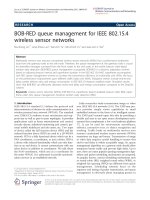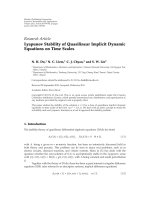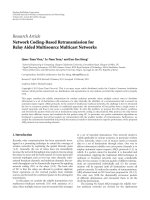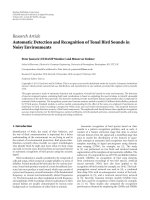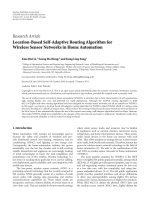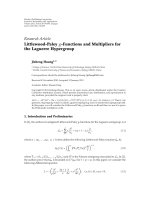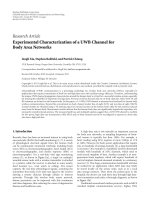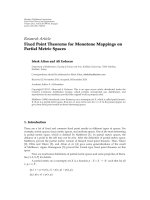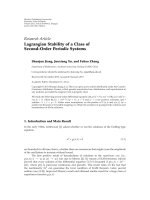Báo cáo hóa học: " Research Article Decentralized Detection in IEEE 802.15.4 Wireless Sensor Networks" doc
Bạn đang xem bản rút gọn của tài liệu. Xem và tải ngay bản đầy đủ của tài liệu tại đây (914.75 KB, 10 trang )
Hindawi Publishing Corporation
EURASIP Journal on Wireless Communications and Networking
Volume 2010, Article ID 174063, 10 pages
doi:10.1155/2010/174063
Research Article
Decentralized Detection in IEEE 802.15.4 Wireless
Sensor Networks
Marco Martal
`
o,
1
Chiara Buratti,
2
Gianluigi Ferrari,
1
and Roberto Verdone
2
1
Wireless Ad hoc and Sensor Networks (WASN) Laboratory, Dep artment of Information Engineering, University of Parma,
Viale G. P. Usbert i 181/A, I, 43100 Parma, Italy
2
Wireless Communication Laboratory (WiLab), Department of Electronics, Computer Sciences, and Systems,
University of Bologna, Viale Risorgimento 2, I, 40136 Bologna, Italy
Correspondence should be addressed to Marco Martal
`
o,
Received 18 February 2010; Revised 11 June 2010; Accepted 23 August 2010
Academic Editor: Carles Anton-Haro
Copyright © 2010 Marco Martal
`
o et al. This is an open access article distributed under the Creative Commons Attribution License,
which permits unrestricted use, distribution, and reproduction in any medium, provided the original work is properly cited.
We present a mathematical model to study decentralized detection in clustered wireless sensor networks (WSNs). Sensors and
fusion centers (FCs) are distributed with the aim of detecting an event of interest. Sensors are organized in clusters, with FCs acting
as cluster heads, and are supposed to observe the same common binary phenomenon. A query-based application is accounted
for; FCs periodically send queries and wait for replies coming from sensors. After reception of data, FCs perform data fusion
with a majority-like fusion rule and send their decisions to an access point (AP), where a final data fusion is carried out and an
estimate of the phenomenon is obtained. We assume that sensors are IEEE 802.15.4-compliant devices and use the medium access
control (MAC) protocol defined by the standard, based on carrier-sense multiple access with collision avoidance. Decentralized
detection and MAC issues are jointly investigated through analytical modelling. The proposed framework allows the derivation of
the probability of decision error at the AP, when accounting for packets’ losses due to possible collisions. Our results show that
MAC losses strongly affect system performance. The impact of different clustering configurations and of noisy communications is
also investigated.
1. Introduction and Related Work
Wireless sensor networks (WSNs) have become an interest-
ing research topic, both in military and civilian scenarios [1].
Remote environmental monitoring, such as surveillance of
reserved areas, are important fields of application of WSNs.
These applications often require very low-power consump-
tion, low-cost hardware [2], and clustering has been pro-
posed as a possible approach for saving energy. As an exam-
ple, when contention-based medium access control (MAC)
protocols are used, splitting nodes in small clusters not inter-
fering among them allows to decrease the time needed for
accessing the channel and, therefore, the energy consumed.
In fact, the smaller is the number of nodes competing for
the channel, the lower will be the probability to find the
channel busy and to delay transmissions. The increasing
interest for WSNs has spurred a significant activity on the
design of efficient distributed detection techniques, allowing
to efficiently detect a physical phenomenon of interest, while
keeping the node complexity as low as possible [3–7].
We consider a network performing a specific decentral-
ized detection task: sensor nodes (hereafter denoted as sen-
sors) observe a binary phenomenon that is spatially constant,
meaning that each sensor observes (neglecting observation
noise) the same value of the phenomenon. Nodes are
grouped into clusters and directly connected with local fusion
centers (FCs), one per cluster, which send periodic queries
to simultaneously poll all sensors in a cluster. The majority-
like distributed detection strategy used in this paper leads to
estimate the phenomenon status which is observed by the
majority of the sensors. This is meaningful, for example,
when it is of interest to detect if the phenomenon under
observation (e.g., temperature, humidity, pressure, presence
of a dangerous gas, etc.) overcomes a critical threshold.
In [8], a general framework on decentralized detection in
clustered WSNs, accounting for communication noises and
2 EURASIP Journal on Wireless Communications and Networking
AP
FCs
Sensors
(clusters)
···
(a)
AP
FC
Sensors
Noisy
observations
Possibly noisy
comm. links
H
No collisions
Collisions
(IEEE 802.15.4)
Ideal
comm. links
Phenomenon H
c
E
···
···
(b)
Figure 1: Logical representation of a clustered sensor network (case
(a)) and detailed representation of a specific cluster highlighted
above (case (b)).
different clustered topologies, is presented. This analysis was
carried out by considering an ideal MAC protocol, that is,
in the absence of collisions. In this paper, we extend this
approach to scenarios where collisions and MAC failures may
occur due to the contention-based nature of the channel
access mechanism. The impact of the MAC protocol on
decentralized detection in clustered WSNs is analyzed. To the
best of the authors’ knowledge, there are no works, in the
literature, dealing with distributed detection and contention-
based MAC protocols jointly. As reference standard for the
MAC, we consider the IEEE 802.15.4 [9]. However, the
framework presented here can be extended to any MAC
protocol.
IEEE 802.15.4 standard refers to a short-range wireless
technology intended for Personal Area Networks (PANs).
According to the standard, sensors use a carrier-sense mul-
tiple access with collision avoidance (CSMA/CA) protocol to
access the channel. A recently proposed mathematical model
for IEEE 802.15.4 networks is used in this paper to evaluate
the Packet Success Probability (PSP), that is, the probability
that a sensor can transmit correctly its packet (i.e., without
collisions) to the PAN coordinator, when competing with
the other sensors in the network [10, 11]. Even though
in the literature there exist some models for the IEEE
802.15.4 MAC protocol [12–15], none of these can be applied
to query-based applications, where sensors have only one
packet per query to be transmitted [10, 11]. All the above
mentioned models, in fact, assume that packets transmitted
from different sources collide with constant and independent
probabilities, regardless of the backoff stage. However, this
assumption is not accurate for query-based applications,
where the number of sensors accessing the channel varies
over time. Moreover, some of these models (e.g., [12, 14])
do not show a good agreement with simulation results.
The model used in the current paper, instead, has been
validated through simulations [10, 11] and experimental
measurements [16].
We consider the reference scenario shown in Figure 1;
FCs act as PAN coordinators gathering data from sensors
belonging to their clusters and transmitting their decisions
to the final destination, denoted as access point (AP). We
assume that a different network (e.g., an infrastructure-based
network where radio resources are scheduled) is used for
the communication between the FCs and the AP and there
are no MAC losses (i.e., a contention-free access is used).
In this case, FCs will act as gateways between two different
networks: the IEEE 802.15.4 network and the infrastructure-
based network.
Both uniform and nonuniform clustering configurations
are analyzed. Our results show a strong impact of the IEEE
802.15.4 MAC protocol on the system performance. While in
the case of ideal MAC the best performance is obtained in the
absence of clustering, on the opposite, when MAC collisions
are considered, splitting sensors in noninterfering clusters
allows reducing collisions within clusters and leads to better
performance. Finally, the presence of noisy communication
links between the sensors and the FCs is considered and its
relative impact, with respect to MAC collisions, is analyzed.
The paper is structured as follows. In Section 2, the
mathematical framework for decentralized detection is pre-
sented. Section 3 describes the IEEE 802.15.4 MAC protocol.
In Section 4, a new mathematical model, accounting for
decentralized detection and MAC issues jointly, is derived.
Finally, Sections 5 and 6 report numerical results and
concluding remarks, respectively.
2. Decentralized Detection in Clustered
Sensor Networks
2.1. Preliminaries on Decentralized Detection. In this section,
we provide the reader with a few preliminaries on decen-
tralized detection of a common binary phenomenon in the
presence of an ideal (collision-less) MAC protocol [8].
We consider a network scenario where n sensors observe
a common binary phenomenon whose status is defined as
follows:
H
=
⎧
⎨
⎩
H
0
with probability p
0
,
H
1
with probability 1 − p
0
,
(1)
where p
0
P{H = H
0
}, P{A} being with the probability
that the event A happens. The sensors are clustered into
EURASIP Journal on Wireless Communications and Networking 3
n
c
<ngroups, and each sensor can communicate only with
its local FC. The groups may have either the same or different
dimensions, depending on the distribution of the sensors
among the clusters. In the former case, clustering is referred
to as uniform whereas in the latter the topology is referred to
as nonuniform.
The FCs collect data from the sensors in their corre-
sponding clusters and make local decisions on the status of
the binary phenomenon. Each local FC then transmits to the
AP, which makes the final decision. A logical representation
of the overall considered architecture is shown in Figure 1(a),
whereas Figure 1(b) shows a more detailed view of a scenario
with a single cluster and the AP.
The observed signal at the ith sensor can be expressed as
r
i
= c
E
+ w
i
i = 1, ,n
,(2)
where
c
E
⎧
⎨
⎩
0ifH = H
0
,
s if H
= H
1
,
(3)
and
{w
i
} are additive noise samples. Note that s is considered
as a deterministic parameter. Assuming that the noise
samples
{w
i
} are independent random variables with the
same Gaussian distribution N (0, σ
2
), the common signal-to-
noise ratio (SNR) at the sensors, denoted as SNR
sensor
,canbe
defined as [17]
SNR
sensor
s
2
σ
2
.
(4)
Each sensor makes a decision comparing its observation
r
i
with a threshold value τ (the same at all sensors, for
simplicity) and computes a local decision u
i
= U(r
i
− τ),
where U(
·) is the unit step function. In particular, τ is equal
to s/2.
In a scenario with noisy communication links, simply
modeled as binary symmetric channels (BSCs), the decision
u
i
sent by the ith sensor can be flipped with a probability
corresponding to the cross-over probability of the BSC
model and denoted as p [18]. This simplified model is
accurate only in the presence of additive communication
noise, without other impairments, such as intersymbol
interference and path loss. For instance, when additive white
Gaussian noise (AWGN) and binary phase shift keying are
considered, it holds that p
= Q(
√
γ
b
), where γ
b
is the channel
SNR and Q(x)
+∞
x
(1/
√
2π)exp(−y
2
/2) dy.Thereceived
bit at the FC can be expressed as u
i
with probability 1 − p,
and 1
− u
i
with probability p.
The majority-like fusion rule used at the FCs and the AP
is defined as follows:
Γ
(
x
1
, , x
M
, k
)
⎧
⎪
⎪
⎪
⎪
⎪
⎪
⎨
⎪
⎪
⎪
⎪
⎪
⎪
⎩
0if
M
m=1
x
m
<k,
1if
M
m=1
x
m
≥ k,
(5)
where x
1
, , x
M
are the M binary data (x
m
∈{0,1})tobe
fused together and k
∈{0, , M} is the decision threshold.
By denoting the number of sensors in the ith cluster as
d
(i)
c
(i = 1, ,n
c
), the following decision thresholds will be
set: (i) k
i
=d
(i)
c
/2+ 1 is the decision threshold at the ith FC
with size d
(i)
c
; (ii) k
f
=n
c
/2 + 1 is the decision threshold at
the AP. In the presence of uniform clustering, d
(i)
c
= d
c
for all
i.
Note that in the absence of clustering, the overall network
architecture shown in Figure 1(a) collapses into a single
cluster and the AP coincides with the corresponding cluster
FC.
2.2. Probability of Decision Error at the AP. When an ideal
(collision-less) MAC protocol is considered, the number of
data packets received at an FC is equal to the number of
sensors in the corresponding cluster, since no losses at MAC
leveloccur.WedenotebyD the n
c
-dimensional vector
containing the number of decisions received at the n
c
FCs.
In the case with ideal MAC protocol, it holds that
D
= (d
(1)
c
, d
(2)
c
, , d
(n
c
)
c
), assuming that
n
c
i=1
d
(i)
c
= n.
Furthermore, define also the following two probability
vectors:
P
1|1
p
1|1
1
, p
1|1
2
, , p
1|1
n
c
,
P
1|0
p
1|0
1
, p
1|0
2
, , p
1|0
n
c
,
(6)
where p
1|1
(p
1|0
, resp.) is the probability that the -th FC ( =
1, , n
c
)decidesforH
1
when H
1
(H
0
, resp.) has happened.
The elements of P
1|1
(equivalently, the elements of P
1|0
)
are, in general, different from each other and depend on the
particular distribution of the sensors among the clusters. We
first consider ideal communication links between the sensors
and the FCs. Note that in this case an error may still occur
due to the quantization of the sensors’ observations and the
fusion operation performed by the FCs.
In [8], it is shown that the probability of decision error
can be expressed as follows:
P
e
= p
0
n
c
i=k
f
n
c
i
j=1
n
c
=1
c
i,j
(
)
p
1|0
+
1 − c
i,j
(
)
1 − p
1|0
+
1 − p
0
k
f
−1
i=0
n
c
i
j=1
n
c
=1
c
i,j
(
)
p
1|1
+
1 − c
i,j
(
)
×
1 − p
1|1
,
(7)
where c
i,j
= (c
i,j
(1), , c
i,j
(n
c
)) is the vector of FCs’
decisions. The index j designates the jth configuration,
over the
n
c
i
possible, with i “1”s (and, obviously, n
c
− i
“0”s). For example, c
1,2
is the second possible configuration
with one “1” (and two “0s”); the “1” is the decision of the
second FC. The rationale behind (7) is the following. The
first summation at the right-hand side of (7) represents the
probability that the AP decision on the phenomenon status
is in favor of H
1
and H
0
is the true status. This happens when
4 EURASIP Journal on Wireless Communications and Networking
at least k
f
=n
c
/2 +1(overn
c
decisions coming from
the FCs) are in favor of H
1
, due to the majority-like fusion
rule. Similarly, the second summation at the right-hand side
of (7) represents the probability that the AP decision on
the phenomenon status is in favor of H
0
and H
1
is the true
status. This happens when less than k
f
=n
c
/2 +1(overn
c
decisions coming from the FCs) are in favor of H
1
.
Finally, in a scenario with noisy communication links,
the probability of decision error can be derived from (7), by
replacing the probabilities
{p
1|i
}
i=0,1
=1, ,n
c
with the probabilities
{p
1|i
,noisy
}
i=0,1
=1, ,n
c
, which take into account the noise in the
communication links between sensors and FCs and are
defined as follows:
p
1|0
,noisy
d
()
c
=
d
()
c
m=k
d
()
c
m
P
m
10
P
d
()
c
−m
00
,(8)
p
1|1
,noisy
d
()
c
=
d
()
c
m=k
d
()
c
m
P
m
11
P
d
()
c
−m
01
,(9)
where k
depends on the number of packets received at the
-th FC. Since the same majority-like fusion rule of the AP is
applied to each FC, the same considerations given above for
k
f
still apply here for the value of k
.
In (8), P
10
= 1 − P
00
is the probability that a sensor
decision sent to an FC is in favor of H
1
when H
0
has
happened and can be expressed, according to the BSC model
for a noisy communication link, as
P
10
= Q
(
τ
)
1 − p
+
[
1 − Q
(
τ
)
]
p.
(10)
In fact, the first term at the right-hand side is obtained when
there is an observation error but error-free communications
whereas the second term is obtained when there is no
observation but communication noise. Similarly, in (9),
P
11
= 1 − P
01
represents the probability that a decision sent
byasensortoanFCisinfavorofH
1
when H
1
has happened
and can be given the following expression:
P
11
= Q
(
τ − s
)
1 − p
+
[
1 − Q
(
τ − s
)
]
p.
(11)
For large values of the sensor SNR, a floor on the
probability of decision error can be computed from (8)and
(9), by setting SNR
sensor
→∞and, therefore, s →∞. Since
τ
= s/2, it is easy to obtain that
p
1|0
,noisy
d
()
c
→
SNR
sensor
→∞
d
()
c
m=k
⎛
⎝
d
()
c
m
⎞
⎠
P
m
1 − p
d
()
c
−m
,
p
1|1
,noisy
d
()
c
→
SNR
sensor
→∞
d
()
c
m=k
⎛
⎝
d
()
c
m
⎞
⎠
1 − p
m
p
d
()
c
−m
.
(12)
Therefore, the probability of decision error in a scenario
with noisy communication links, given a clustering configu-
ration (i.e., D), becomes
P
e
SNR
sensor
, p | D
=
p
0
n
c
i=k
f
nc
i
j=1
n
c
=1
c
i,j
(
)
p
1|0
,noisy
d
()
c
+
1 − c
i,j
(
)
1 − p
1|0
,noisy
d
()
c
+
1 − p
0
k
f
−1
i=0
nc
i
j=1
n
c
=1
c
i,j
(
)
p
1|1
,noisy
d
()
c
+
1 − c
i,j
(
)
1 − p
1|1
,noisy
d
()
c
.
(13)
At the left-hand side of (13), we have explicitly indicated that
P
e
depends on the observation quality (i.e., SNR
sensor
)and
the communication quality (i.e., p).
3. The Packet Success Probability
with IEEE 802.15.4 MAC Protocol:
An Analytical Approach
We consider a network composed of IEEE 802.15.4-
compliant sensors, working in beacon-enabled mode [9].
Each FC coincides with a PAN coordinator, receiving data
from sensors belonging to its PAN (i.e., its cluster). We
assume that the different clusters use the same frequency
channel, but different resources in terms of time. In other
words, a time division between clusters is applied, so that
sensors of different clusters do not interfere among them.
We evaluate performance by fixing the total time made
available to all sensors in the network (i.e., all the clusters) for
transmitting data to the FCs. This means that performance is
evaluated under a total achievable throughput constraint. In
this section, we consider an illustrative cluster composed of
d
c
(IEEE 802.15.4) sensors transmitting data to the FC. We
assume that no connectivity problems exist; each sensor can
receive the query (i.e., the beacon packets) from the FC and
reach it. Nodes transmit packets with size D
· 10 bytes, being
D an integer parameter.
According to the IEEE 802.15.4 MAC protocol in beacon-
enabled mode, the access to the channel is managed through
a superframe, starting with a packet, denoted as beacon,
transmitted by the PAN coordinator [9]. The superframe
may contain an inactive part, allowing sensors to enter in
sleeping mode whereas in the active part sensors use a slotted
CSMA/CA algorithm to transmit data. The duration of the
active part, namely, the superframe duration, and of the
entire superframe, namely, the beacon interval, depend on the
value of two integer parameters ranging from 0 to 14, called
superframe order (SO)andbeacon order (BO), respectively.
In particular, the superframe duration can be expressed as
960
·2
SO
·T
s
,whereT
s
=16 μs is the symbol time whereas the
beaconintervalisgivenby960
· 2
BO
· T
s
(see Figure 2).
EURASIP Journal on Wireless Communications and Networking 5
960 2
SO
T
S
960 2
BO
T
S
960 2
SO
T
S
960 2
BO
T
S
Active part
superframe FC1
and inactive part
superframe FC2
Active part
superframe FC2
and inactive part
superframe FC1
Beacon
Beacon
Beacon
Beacon
Figure 2: The time division between clusters, when two FCs are
present.
Time division between clusters is performed as follows.
The application sets the value of BO, that is the total time
made available to the network for transmissions from sensors
to FCs. If the AP does not know the clusters size, it allocates
the same resource to all the clusters, that is the same value of
SO.Inparticular,SO is set accordingly to the value of BO and
the number of clusters, such that all clusters have a portion
of the beacon interval allocated. If, instead, the AP is aware
of the network topology, it may allocate resources according
to the number of sensors in each cluster. In this case, the AP
assigns different values of SO according to the clusters’ sizes;
the smaller the cluster, the smaller the value of SO assigned
to it. Both the above mentioned resource allocation strategies
will be considered in Section 5. The AP communicates to the
FCs the values of SO and BO and the instant in which the
superframe of each FC must start. In this way, the active
parts of the superframes defined by the different FCs will
not overlap and during transmissions within a given cluster,
sensors belonging to the other clusters will be in sleeping
mode, being in the inactive part of the superframe of their
FCs (see Figure 2). According to our application, each FC
will send periodic queries, starting from the instant provided
by the AP, and will wait for decisions coming from sensors.
The application also requires that the data must be received
by the FC by the end of the active part of the superframe
defined by the FC. Therefore, each sensor has one packet to
be transmitted per beacon received and has to transmit it
by the end of the active part of the superframe defined by
its FC.
In [10, 11], a mathematical model for the IEEE 802.15.4
MAC protocol in beacon-enabled mode is introduced. This
model describes the behavior of a sensor accessing the
channel by using the slotted CSMA/CA algorithm and allows
the evaluation of the PSP, denoted, hereafter, as p
MAC
,
and representing the probability that a sensor transmits
successfully the packet to its FC by the end of the active
part of the superframe of its FC. A packet could be lost due
to the following reasons: (i) a collision, (ii) the channel is
sensed busy more than five consecutive times [9], (iii) the
available time ends before the channel is sensed idle. Note
that retransmissions are not allowed in our scenario.
0
0.2
0.4
0.6
0.8
1
p
MAC
0 10203040506070
d
c
D = 2, SO = 0
D
= 2, SO = 1
D
= 2, SO = 2, 3, 4
Figure 3: p
MAC
, as a function of d
c
,fordifferent values of SO.
For the sake of conciseness, we do not report here the
analysis made to derive p
MAC
but we refer to [10, 11]. To show
the behavior of p
MAC
when varying different parameters,
in Figure 3, p
MAC
is shown, as a function of d
c
(a single
cluster is considered), for different values of SO (assumed
to be equal to BO)andwhenD
= 2. Only the analytical
model results are reported and we refer to [10, 11] for the
validation of the model. p
MAC
decreases by increasing d
c
,
since more sensors compete for the channel (i.e., the collision
probability increases), and by decreasing SO, since less time
is given to sensors to try to access the channel. Since sensors
start the CSMA/CA algorithm at the same time, they can
sense the channel for a limited number of times and no
retransmissions are allowed, it will exist a maximum delay
with which sensors can access the channel [11]. For this
reason, performance achieved in the cases SO
= 1and2is
almost the same.
4. Impact of the Channel Access Probability on
Decentralized Detection
In this section, we derive an analytical framework for the
computation of the probability of decision error in the
presence of the IEEE 802.15.4 MAC protocol. Each FC will
receive a number of decisions smaller than the number of
sensors in the cluster, owing to the contention-based nature
of the protocol, that may cause collisions.
Equation (13) needs to be modified to take into account
the presence of a nonideal MAC protocol, characterized,
concisely, by p
MAC
≤ 1.
Being p
MAC
(d
c
) the PSP in a scenario with d
c
competing
sensors in a cluster and assuming that all transmissions
are independent, it follows that the number of successful
transmissions in the j-th cluster can be modeled as a
binomial random variable, denoted as D
(j)
c
(j = 1, , n
c
),
with parameters d
(j)
c
and p
MAC
(d
(j)
c
). Referring to the analysis
6 EURASIP Journal on Wireless Communications and Networking
in Section 2, the n
c
-dimensional vector, with the numbers
of decisions received by the FCs, is a random vector
D (D
(1)
c
, D
(2)
c
, , D
(n
c
)
c
). ( The symbol D was used
in Section 2.2 for a deterministic vector. With an abuse of
notation, it now refers to a random vector. The context
eliminates any ambiguity.) Note that even through the
clusters are uniform, the number of decisions received at the
FCs may vary from cluster to cluster, being such number a
random variable. Therefore, the true clustering configuration
is nonuniform.
At this point, the probability of decision error depends on
a realization of the random vector D which, in turn, depends
on P
1|1
and P
1|0
. The average probability of decision error,
with respect to the clustering configuration, can then be
computed as follows:
P
e
SNR
sensor
, p
= E
D
P
e
SNR
sensor
, p | D
.
(14)
After a few manipulations, one obtains that
P
e
SNR
sensor
, p
=
d
(1)
c
i
1
=0
d
(2)
c
i
2
=0
···
d
(n
c
)
c
i
n
c
=0
P
D
(1)
c
= i
1
× P
D
(2)
c
= i
2
···P
D
(n
c
)
c
= i
n
c
·
P
e
SNR
sensor
, p | D
(1)
c
= i
1
, D
(2)
c
=i
2
, , D
(n
c
)
c
=i
n
c
,
(15)
where the last probability at the right-hand side is given by
(13)(withd
(j)
c
= i
j
, j = 1, , n
c
)and
P
D
()
c
= i
=
d
()
c
i
p
MAC
d
()
c
i
1 − p
MAC
d
()
c
d
()
c
−i
.
(16)
It would be interesting to preliminary evaluate a lower
bound on the average probability of decision error, as the
limiting average probability of decision error in an ideal
scenario with no observation and communication noises,
that is, for SNR
sensor
→∞and p = 0. In this case, if at least
one bit is delivered to the AP, then a correct decision will be
made. At this point, there is a decision error ifandonlyif no
sensor decisions can be reliably sent to the AP. Therefore, an
error happens only if i
= 0, for all ∈{1, , n
c
}. In this
case, the AP decides randomly, thus obtaining that
P
e,lim
= P
D
(1)
c
= 0
P
D
(2)
c
= 0
···P
D
(n
c
)
c
= 0
·
P
e
SNR
sensor
, p | D
(1)
c
= 0, D
(2)
c
= 0, , D
(n
c
)
c
= 0
=1/2
=
1
2
n
c
i=1
1 − p
MAC
d
(i)
c
d
(i)
c
.
(17)
In the presence of uniform clustering, that is, d
(i)
c
= d
c
,forall
i,(17)reducesto
P
e,lim
=
1
2
1 − p
MAC
(
d
c
)
d
c
n
c
=
1
2
1 − p
MAC
(
d
c
)
n
,
(18)
where we have used the fact that n
c
· d
c
= n, regardless of
the (uniform) clustering configuration. It can be observed
that expression (18)for
P
e,lim
is a decreasing function of the
number of clusters. On the opposite, in a scenario with an
ideal MAC protocol, this limiting probability does not depend
on d
c
[8]. As an example, in the case n = 64, D = 2,
BO
= 3, when no clustering is applied, P
e,lim
will be equal to
10
−5
(see Figure 5(b)). By increasing the number of clusters,
p
MAC
gets larger and, therefore, the floor appears at very
small (and not practical) values of the probability of decision
error (e.g., in the case with eight uniform clusters we have
P
e,lim
= 6 · 10
−22
). Finally, note that the limiting probability
(17) equals to zero for any unbalanced configuration with
at least one cluster with one sensor. In this case, in fact,
the sensor directly connected to its FC always accesses the
channel and, therefore, there is always at least one correct
decision (sent by the corresponding FC to the AP) on the
basis of which the AP can correctly estimate the phenomenon
status.
5. Numerical Results
We now investigate the performance of the proposed decen-
tralized detection schemes. In particular, in the presence of
IEEE 802.15.4 MAC protocol the value of p
MAC
is determined
offline, for a given clustering configuration, by using the
analytical framework presented in Section 3. The obtained
value is then used in (15) and in our simulator. In particular,
our C simulator is designed “ad hoc” as follows. The
transmissions from the sensors to the FCs are represented as
Bernoulli trials, each with parameter p
MAC
. On the basis of
the received packets in their cluster, the FCs perform a data
fusion (with decision threshold set according to the number
of received packets) and transmit their decisions to the AP.
Since each sensor must send only its decision (i.e., one bit)
and since the model requires that sensors transmit packets
of size multiple of 10 bytes [11], being the packet header
equal to 19 bytes, we set D
= 2, that is, packets of 20 bytes
are transmitted. In the following, we set n
= 64 and the
MAC parameters to the default values (see [11]). We first
consider uniform resources allocation among clusters. Then,
in Figure 7, we extend our approach to a scenario where
resources are allocated accordingly to the cluster size. Note
that in the first case, uniform clustering will be favored with
respect to the nonuniform case, since resources will be better
used. By the way, in scenarios where the AP is not aware of
the network topology, only the uniform resource allocation
can be implemented.
Unless otherwise stated, we set BO
= 3 and (apart from
Figure 7)wesetSO
= BO = 3(i.e.,wegivetothecluster
all the available time) when n
c
= 1; SO = 2(i.e.,two
EURASIP Journal on Wireless Communications and Networking 7
10
−6
10
−5
10
−4
10
−3
10
−2
10
−1
10
0
P
e
−10 −50 5101520
SNR
sensor
(dB)
Simulations / 40-8-8-8
Analysis / 40-8-8-8
Simulations / 16-16-16-16
Analysis / 16-16-16-16
Figure 4: Comparison between analytical and simulation results
in a scenario with ideal communication links and two possible
clustering configurations.
nonoverlapping active parts within the beacon interval are
present) when n
c
= 2; SO = 1 when n
c
= 3and4;SO = 0
when n
c
= 5 and 8. Note that in the cases n
c
= 3andn
c
= 5
part of the beacon interval is not used by any cluster and,
therefore, some resources are wasted, due to the constraint
that SO must be an integer.
In Figure 4, a comparison between analytical and sim-
ulation results in a scenario with IEEE 802.15.4 MAC
protocol and ideal communication links (i.e., no noisy
communication links) and two possible clustering configu-
rations, uniform (16-16-16-16) and nonuniform (40-8-8-8),
is proposed.
As expected, a good agreement between simulations
and analytical results was found in both cases. In fact, the
analysis carried out in Section 4 is exact and the simulator is
implemented by exactly replicating the analysis conditions.
In other words, this is a “sanity check,” which allows us to
use the simulator, especially to avoid numerical problems in
the evaluation of the analytical formulas.
In Figure 5, the probability of decision error is shown,
as a function of the sensor SNR, for different clustering
configurations. No noisy communication links are accounted
for and ideal MAC is considered in case (a) whereas the IEEE
802.15.4 MAC protocol is accounted for in case (b). The use
of the IEEE 802.15.4 MAC protocol leads to a performance
degradation with respect to the case of ideal MAC. The
highest degradation is achieved with no clustering, since in
this case a large number of sensors are competing for the
radio resource. The best configuration, in the case with IEEE
802.15.4 MAC protocol is achieved for n
c
= 8, where only
eight sensors per cluster are competing for the channel, and
even though SO
= 0 (i.e., sensors have only approx. 15 ms to
access the channel), the success probability is the largest. By
comparing curves in (a) and (b) we can observe that, while
distributed detection is mainly affected by the uniformity
or nonuniformity of clusters, rather than by the number of
clusters itself, MAC losses strongly depend on the value of n
c
.
In fact, while in the ideal case the performance of uniform
clustering does not depend on the specific configuration,
this is no longer true in the presence of contention-based
MAC protocols. Moreover, note that the case (40-8-8-8)
outperforms the case (32-8-8-8-8), since even though more
sensors are competing for the channel (in the largest cluster),
sensors have more time to access the channel (i.e., SO
= 1
instead of 0). In fact, we have p
MAC
= 0.23 in the cluster
with 40 sensors and SO
= 1, and p
MAC
= 0.13 in the
cluster with 32 sensors and SO
= 0. This means that the best
performance is achieved when a good balance between the
number of sensors competing for the channel and the time
made available to sensors for transmissions is reached.
ThecomparisonmadeinFigure 5 is done by assuming
that all decisions coming from the FCs have the same
reliability. This implies that the same weight is assigned to
all FCs’ decisions. However, in nonuniform scenarios the
decisions obtained by fusing a larger number of sensors’
decisions are more reliable than those obtained by fusing a
smaller number of sensors’ decisions. Therefore, one may
resort to a weighing strategy, where the AP decides according
to the following rule:
Ψ
y
1
, , y
M
⎧
⎪
⎪
⎪
⎪
⎪
⎪
⎨
⎪
⎪
⎪
⎪
⎪
⎪
⎩
0if
M
m=1
w
m
y
m
< 0,
1if
M
m=1
w
m
y
m
≥ 0,
(19)
where y
1
, , y
M
are the M data (y
m
= 2x
m
− 1) to be fused
together and w
1
, , w
M
are the weights computed as the
number of sensors in the cluster (which successfully access
the channel) divided by the total number of sensors (which
successfully access the channel). In Figure 6,
P
e
is shown,
as a function of the sensor SNR, for different clustering
configurations, ideal communication links, and weighing
strategy at the AP. Two scenarios for the MAC are considered:
(a) ideal MAC protocol and (b) IEEE 802.15.4 MAC
protocol. In the scenario with ideal MAC protocol, one can
observe that the nonuniform configurations experience the
expected performance improvement. Moreover, the higher
is the nonuniformity degree, the larger is this improvement.
On the other hand, when the IEEE 802.15.4 MAC protocol is
considered, one can observe that the weighing strategy has no
significant impact and the performance is the same predicted
in Figure 5(b). This is probably due to the fact that, while in
the case with no weighing strategy the performance is given
by the average number of sensors accessing the channel, in
the presence of weighing the performance is determined by
the overall statistics of the number of sensors accessing the
channel.
In Figure 7, we show the performance achieved when
resources (in terms of time) are allocated to clusters depend-
ing on their size. In particular, we set BO
= 3andweallocate
SO
= 0 to clusters with 8 sensors, SO = 1toclusterswith
16 sensors, SO
= 2toclusterswith32sensors,andSO = 3
8 EURASIP Journal on Wireless Communications and Networking
10
−6
10
−5
10
−4
10
−3
10
−2
10
−1
10
0
P
e
−10 −50 5101520
SNR
sensor
(dB)
No clustering
Uniform clustering
32-8-8-8-8
40-8-8-8
56-4-4
(a)
10
−6
10
−5
10
−4
10
−3
10
−2
10
−1
10
0
P
e
−10 −50 5 101520
SNR
sensor
(dB)
No clustering
32-32
16-16-16-16
8-8-8-8-8-8-8-8
32-8-8-8-8
40-8-8-8
56-4-4
(b)
Figure 5: P
e
as a function of the sensor SNR, for different clustering configurations and ideal communication links. Case (a): ideal MAC;
case (b): IEEE 802.15.4 MAC.
10
−6
10
−5
10
−4
10
−3
10
−2
10
−1
P
e
−10 −50 5101520
SNR
sensor
(dB)
No clustering
Uniform clustering
32-8-8-8-8
40-8-8-8
56-4-4
(a)
10
−6
10
−5
10
−4
10
−3
10
−2
10
−1
P
e
−10 −50 5101520
SNR
sensor
(dB)
No clustering
32-32
16-16-16-16
32-8-8-8-8
40-8-8-8
56-4-4
(b)
Figure 6: P
e
as a function of the sensor SNR, for different clustering configurations, ideal communication links, and weighing strategy at
the AP. Case (a): ideal MAC; case (b): IEEE 802.15.4 MAC.
to the nonclustering case. In this way, the resource available
to each cluster is proportional to the cluster size and also
no resources are wasted for the considered set of network
topologies. As expected, the performance of the nonuniform
cases slightly improve with respect to those with uniform
resource allocation (see, e.g., the case (32-8-8-8-8) present in
both the figures). In particular, when the weighing strategy is
applied, the results related to the nonuniform scenarios are
approximatively the same. However, uniform configurations
are still to be preferred.
Since increasing the number of FCs will increase also
the cost of the network, being FCs sensors with special
functionalities, and therefore high cost, it is of interest to
investigate what is the best possible configuration for a fixed
number of FCs. Only results in the presence of the IEEE
802.15.4 MAC protocol will be presented in the following
figures. In Figure 8, the probability of decision error is
shown, as a function of the sensor SNR, in a scenario with
n
= 64 and 4 FCs. Two different values of p are considered: 0
(ideal communication links) and 0.1 (high communication
noise). In the ideal case, the uniform configuration is still
to be preferred, thus confirming the results in [8]withan
ideal MAC protocol. Moreover, the larger the nonuniformity
degree, the worse is the performance. In fact, when clusters
EURASIP Journal on Wireless Communications and Networking 9
10
−6
10
−5
10
−4
10
−3
10
−2
10
−1
10
0
P
e
−10 −50 5 101520
SNR
sensor
(dB)
No clustering
32-32
16-16-16-16
8-8-8-8-8-8-8-8
32-8-8-8-8
32-16-8-8
32-16-16
(a)
10
−6
10
−5
10
−4
10
−3
10
−2
10
−1
P
e
−10 −50 5 101520
SNR
sensor
(dB)
No clustering
32-32
16-16-16-16
32-8-8-8-8
32-16-8-8
32-16-16
(b)
Figure 7: P
e
as a function of the sensor SNR, for different clustering configurations, ideal communication links, and the IEEE 802.15.4 MAC
protocol. Case (a): absence of weighing; case (b): presence of weighing.
10
−6
10
−5
10
−4
10
−3
10
−2
10
−1
10
0
P
e
p = 0
p
= 0.1
−10 −50 5 1015 20
SNR
sensor
(dB)
16-16-16-16
24-14-13-13
30-12-11-11
40-8-8-8
61-1-1-1
Figure 8: P
e
as a function of the SNR, in a scenario with n = 64
and different clustering configurations with 4 FCs. Two scenarios
are considered: p
= 0andp = .1.
are balanced, the decisions coming from the FCs to the AP
have approximately the same reliability, since the number of
collisions is approximately the same in all clusters. On the
other hand, with unbalanced clusters the decisions do not
have the same reliability and, therefore, the quality of the AP
decision worsens. In the scenario with p
= .1, the impact
of the communication noise on the probability of decision
error is significant and the performance rapidly degrades.
As predicted in Section 2.2, for large values of SNR curves
present a floor, due to the communication noise. Therefore,
increasing more and more the observation quality does not
10
−6
10
−5
10
−4
10
−3
10
−2
10
−1
10
0
P
e
−10 −50 5101520
SNR
sensor
(dB)
32-32
63-1
16-16-16-16
61-1-1-1
8-8-8-8-8-8-8-8
57-1-1-1-1-1-1-1
n
c
= 2
n
c
= 4
n
c
= 8
Figure 9: P
e
, as a function of the SNR, in a scenario with the IEEE
802.15.4 MAC protocol and ideal communication links.
lead to better performance, since this is also limited by the
communication noise.
In Figure 9,
P
e
is shown, as a function of the SNR,
for different clustering configurations, considering ideal
communication links and the IEEE 802.15.4 MAC protocol.
For each value of n
c
, the best and the worst configurations are
shown. More precisely, the best possible configurations are
uniform for all values of n
c
: 32-32 for n
c
= 2, 16-16-16-16 for
n
c
= 4, and 8-8-8-8-8-8-8-8 for n
c
= 8. On the other hand,
the worst possible configuration, for a given value of n
c
,is
that with one big cluster and the others with only one sensor,
10 EURASIP Journal on Wireless Communications and Networking
that is, 63-1 for n
c
= 2, 61-1-1-1 for n
c
= 4, and 57-1-1-1-1-
1-1-1 for n
c
= 8. One should observe that the relative loss (in
terms of sensor SNR) from the best to worst configuration
is approximately constant, regardless of the value of n
c
.For
instance, at
P
e
= 10
−3
thislossisaround4.5/5dB. This
implies that the gain brought by the use of uniform clustering
is (more or less) the same, the only difference being the fact
that the larger the number of FCs (with a corresponding
larger cost), the better is the performance.
6. Concluding Remarks
In this paper, we have proposed a mathematical framework
to study decentralized detection in IEEE 802.15.4 WSNs.
In particular, on the basis of an analytical computation of
the probability that a packet is correctly received at the
destination when the IEEE 802.15.4 MAC protocol is used,
we have evaluated the impact of the MAC protocol on
a decentralized detection strategy. This analysis has been
carried out considering different clustered topologies. Results
show that the MAC protocol has a relevant impact on the
performance. In particular, while the absence of clustering
guarantees the best performance of a decentralized detection
strategy, in the presence of an ideal MAC, this leads to the
worst performance with the 802.15.4 MAC protocol. In the
latter case, in fact, splitting sensors in clusters noninterfering
among them, leads to decreasing the collision probability
and, therefore, the error probability on the decision. Finally,
the presence of communication noise increases the proba-
bility of decision error floor induced by the MAC protocol,
and this degradation is more pronounced, the higher is the
nonuniformity degree among the clusters.
References
[1] I. F. Akyildiz, W. Su, Y. Sankarasubramaniam, and E. Cayirci,
“A survey on sensor networks,” IEEE Communications Maga-
zine, vol. 40, no. 8, pp. 102–114, 2002.
[2] M. Madou, Fundamentals of Microfabrication, CRC Press,
Boca Raton, Fla, USA, 1997.
[3] J. N. Tsitsiklis, “Advances in statistical signal processing,” in
Decentralized Detection,H.V.PoorandJ.B.Thomas,Eds.,vol.
2, pp. 297–344, JAI Press, Greenwich, Conn, USA, 1993.
[4] R. R. Tenney and N. R. Sandell Jr., “Detection with distributed
sensors,” IEEE Transactions on Aerospace and Electronic Sys-
tems, vol. 17, no. 4, pp. 501–510, 1981.
[5] A. R. Reibman and L. W. Nolte, “Design and performance
comparison of distributed detection networks,” IEEE Trans-
actions on Aerospace and Electronic Systems,vol.23,no.6,pp.
789–797, 1987.
[6] R. Viswanathan and P. K. Varshney, “Distributed detection
with multiple sensors: part I—fundamentals,” Proceedings of
the IEEE, vol. 85, no. 1, pp. 54–63, 1997.
[7] J F. Chamberland and V. V. Veeravalli, “Decentralized detec-
tion in sensor networks,” IEEE Transactions on Signal Process-
ing, vol. 51, no. 2, pp. 407–416, 2003.
[8]G.Ferrari,M.Martal
`
o, and R. Pagliari, “Decentralized
detection in clustered sensor networks,” IEEE Transactions on
Aerospace and Electronic Systems. In press.
[9] IEEE 802.15.4 Standard, “Part 15.4: Wireless Medium Access
Control (MAC) and Physical Layer (PHY) Specifications for
Low- Rate Wireless Personal Area Networks (LR-WPANs),”
Piscataway, New Jersey, 08855-1331: IEEE, 2006, http://stan-
dards.ieee.org/getieee802/802.15.html.
[10] C. Buratti, “A mathematical model for performance of IEEE
802.15.4 beacon-enabled mode,” in Proceedings of Interna-
tional Conference on Wireless Communications and Mobile
Computing (IWCMC ’09), pp. 1184–1190, Leipzig, Germany,
June 2009.
[11] C. Buratti and R. Verdone, “Performance analysis of IEEE
802.15.4 non beacon-enabled mode,” IEEE Transactions on
Vehicular Technology, vol. 58, no. 7, pp. 3480–3493, 2009.
[12] J. Mi
ˇ
si
´
c, S. Shafi, and V. B. Mi
ˇ
si
´
c, “Maintaining reliability
through activity management in an 802.15.4 sensor cluster,”
IEEE Transactions on Vehicular Technology,vol.55,no.3,pp.
779–788, 2006.
[13] S. Pollin, M. Ergen, S. Ergen et al., “Performance analysis of
slotted carrier sense IEEE 802.15.4 medium access layer,” IEEE
Transactions on Wireless Communications,vol.7,no.9,pp.
3359–3371, 2008.
[14] Z. Chen, C. Lin, H. Wen, and H. Yin, “An analytical model
for evaluating IEEE 802.15.4 CSMA/CA protocol in low rate
wireless application,” in Proceedings of the International Con-
ference on Advanced Information Networking and Applications
Workshops (AINAW ’07), pp. 899–904, Niagara Falls, Ontario,
Canada, May 2007.
[15] M. Martal
`
o, S. Busanelli, and G. Ferrari, “Markov Chain-based
performance analysis of multihop IEEE 802.15.4 wireless
networks,” Performance Evaluation, vol. 66, no. 12, pp. 722–
741, 2009.
[16] C. Gezer, C. Buratti, and R. Verdone, “Capture effect in
IEEE 802.15.4 networks: modelling and experimentation,” in
Proceedings of the IEEE International Symposium on Wireless
Pervasive Computing, pp. 204–209, Modena, Italy, May 2010.
[17] W. Shi, T. W. Sun, and R. D. Wesel, “Quasi-convexity and
optimal binary fusion for distributed detection with identical
sensors in generalized Gaussian noise,” IEEE Transactions on
Information Theory, vol. 47, no. 1, pp. 446–450, 2001.
[18] G. Ferrari and R. Pagliari, “Decentralized binary detection
with noisy communication links,” IEEE Transactions on
Aerospace and Electronic Systems, vol. 42, no. 4, pp. 1554–1563,
2006.
